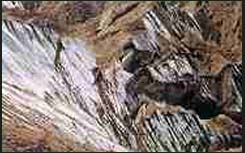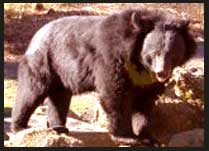|
Travelogues Malari in Dhauli Ganga Valley
|
|||||
Malari in the Dhauli Ganga valley of the Nanda Devi Biosphere reserve is a small village near the Tibet border. This area has been declared as a world heritage site. Located 61 km from Joshimath, it is also possible to reach here from Badrinath. From Joshimath, there are local taxis that ply to Malari, along a kachcha road. Everytime a 'pucca' road is constructed, before long it is swept away by the winter snow and ice or by flooding of the river waters.
On the way to Malari, there are several ice-sheets, that remain unmelted even in the summer months. The river flows swiftly past crossing the road at several places, so road repair is a perennial task. On the way we saw the fabled Dronagiri parvat from where Hanuman is believed to have procured Sanjivani, a plant to save the life of Lakshmana. The villages in this valley include Reni, from where the Chipko movement of Garhwal was started; Gaura Devi, from where the famous chipko activist hailed, as well as Lata, Peng, Tolma, Surai, Phagti, Jamgavar, Kaga and Garpag. About 18 kms from Malari, Niti is the last village in India, bordering Tibet. In times of yore, Niti Pass connected India and Tibet on the trade route. Now, special permission has to be taken from the administration to go beyond Malari. |
More on Uttaranchal • Overview • Uttaranchal Districts • Char Dham Yatra • Corbett National Park • Mussoorie • Badrinath • Haridwar • Rishikesh • Festivals of Kumaon Travelogues • Haridwar to Badrinath • Valley of Flowers • Auli
Impressions
Trekking | ||||
Malari is occupied by Bhotias, who are of Indo-Mongolian origin. The people there told me that there are two types of scheduled tribes-the Tolchas and the Marchhas. The Tolchas are the people living around Malari and the Marchhas live in the upper areas. These people are engaged in sheep rearing and the cultivation of pulses like rajma, grains like ogal and phaphar, potatoes as well as crops like Amaranth. The bhotia people are engaged in the herding of sheep. Grazing is now banned in the forest area due to biosphere reserve restrictions. The vegetation in the Dhauli Ganga valley consists mainly of conifers like deodar (cedarwood), surai (cypress), kail (bluepine). A species of banj (oaks) are found in the higher heights. There are many aromatic plants on the slopes, which are used for making incensesticks and dhup.
Nearly 200 species of birds are found in the Biosphere reserve. Many of the bird species move down to lower altitudes in the lower Himalayas and foothills while a few migrate down to the northern plains and peninsular India in the winters. Eight species of birds found in the area are endangered. They are Monal pheasant (Lophophorus impejanus), Koklas pheasant (Pucrasie macrolopha), Western tragopan (Tragopan melanocephala), Himalayan snowcock (Tetraogallus himalayensis), Golden eagle (Aquila chrysaetos), Steppe eagle (Aquila neplansis), Black eagle (Letinaetus malayensis) and Bearded vulture (Cyptus barbatus). In this polluted world, Malari is a breath of fresh air. One values the fact that places like this are difficult, indeed, to preserve. Those of us who are lucky to visit these remote destinations with a fragile eco-system, grow acutely aware of the need to protect the environment, the endangered birds and animals and the rare and delicate herbs and plants that grow here. I felt deeply moved and inspired by those involved in the Chipko movement of this area, who were ready to die to ensure protection of the trees.
|
|||||
Editor: Romola Butalia (c) India Travelogue. All rights reserved. |
|||||
 At Malari, the villagers were mostly engaged in the cultivation of their fields, an activity possible only in the 6 summer months, after which they relocate during the barren winters in the lower reaches, like Chamoli. For most, the melting water from the glaciers is the chief source of water. The houses at Malari are wooden structures with slated roofs. There are only a few basic shops, and people have to come to Joshimath for their provisions.
At Malari, the villagers were mostly engaged in the cultivation of their fields, an activity possible only in the 6 summer months, after which they relocate during the barren winters in the lower reaches, like Chamoli. For most, the melting water from the glaciers is the chief source of water. The houses at Malari are wooden structures with slated roofs. There are only a few basic shops, and people have to come to Joshimath for their provisions.

 The surveys in the biosphere reserve have resulted in the findings of the presence of 18 mammals. Seven of these are endangered. Some of them are snow leopard (Panthera uncia), black bear (Celenarctos thibetanus), brown bear (Ursus arctos), musk deer (Moschus chrysogaster), bharal (Pseudoisnyaur), Himalayan tahr (Hemitragus jemlahicus), serow (Capricornis sumatraensis).
The surveys in the biosphere reserve have resulted in the findings of the presence of 18 mammals. Seven of these are endangered. Some of them are snow leopard (Panthera uncia), black bear (Celenarctos thibetanus), brown bear (Ursus arctos), musk deer (Moschus chrysogaster), bharal (Pseudoisnyaur), Himalayan tahr (Hemitragus jemlahicus), serow (Capricornis sumatraensis).